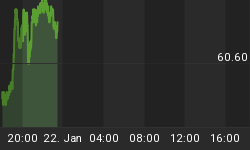Net foreign capital flows into the US slipped 1.4% to $89.1 bln billion in November from a revised $104.2 billion in October (initial was $106.8 bln). Although the $107 billion comfortably exceeded the $64 billion record trade deficit for the corresponding month.
KEY POINT: Despite the 41% and 74% declines in net foreign purchases of US stocks and US Agency securities respectively, and despite the 176% increase in net US purchases of foreign stocks, total net capital inflows increased because private institutions' purchases of US treasury bonds and notes DOUBLED to $50.8 bln, making up 93% of the increase in total purchase of US Treasuries and financing up to 79% of the Nov trade deficit.
POSITIVES
• Total net foreign purchases into US Treasury bonds and notes soared 82% to a record $54.6 bln, 93% of which emerged from nonoffical interest (private organizations usually hedge funds).
• The increase in private flows into treasuries is consistent with the 7.1% increase in holdings of treasuries by Caribbean center-registered entities, which are usually hedge funds. We are aware of the possibility of foreign central banks using these entities as vehicles to purchases US bonds, but these particular flows account for a minority of the real flows by hedge funds.
NEGATIVES
• Purchases of US treasuries by foreign official accounts (central banks and supra nationals) fell 24% to $3.7 bln, making up for a mere 7% of the total increase in foreign purchases of treasuries. More strikingly, official purchases made up less than 50% of the increase for the 5 th straight month.
While the contrasting interest between official and private accounts raises immediate concerns about the trade deficit being at the mercy of speculators, it may well be argued that central banks are snapping up US treasuries via hedge funds and currency overlay managers which fall under the "private" portion. Nonetheless, the fact that a significant share of the US trade imbalance has been increasingly financed by volatile sources such as hedge funds reflects the certain nature of the financing of the external imbalance, whose increase is anything but uncertain.

• Foreign purchases of US stocks fell 41% to $4.7 bln in November, posting the second monthly decline, 2 months after having reached the highest level in 5 years. Many observers have praised the prior surge in US equities as the return of the trend shown 5 years ago when US equities comprised as a large destination for foreign capital.

• Japan, the largest holder of US treasuries has kept its holdings around the $680 bln mark for the past 12 months (see chart below), in contrast with Caribbean offshore centers which have risen 7.1% to $115.3 bln in November, and 65% over the past 12 months. Thus, the conclusion that part of those "hidden" central bank purchases of treasuries flowing via Caribbean offshore centers could be from the central banks of OPEC nations such as the Saudi Arabian Monetary Authority and the National Bank of Kuwait.

• Net flows into US agencies and US corporate bonds fell 74% and 1% respectively to $9 bln and $35 bln. But the flows into corporates accounted for over half of the US trade deficit.
FX Outlook
The dollar has fallen on the heels of the second consecutive monthly decline in headline CPI and the drop in the Nov TICS. The US dollar is no longer fed by the virtuous circle of an increasing interest rate environment, unlimited foreign capital flows into US equities and dollar-bound flows of the Home Investment Act. The dollar outlook must be assessed in terms of the contrasting nature between the surging US trade deficit and the volatile pace of US bound foreign flows. The euro's consolidation around the $1.21 figure marks the midpoint of the 100 and 200 day MAs. The uncertainty of the outcome in the March FOMC meetings should provide more of a negative than a positive for the dollar because even if the Fed does raise rates, such a move will be seen as the last of the cycle, especially given the expected sub- 3.0% reading in Q4 GDP. Whether Q1 GDP is expected to recover the 3.0% handle or not, FX traders may further decrease their enthusiasm for the greenback, due to the looming conclusion of the yield story and the fading of the growth story.
Just as markets should be more receptive to the idea of further ECB rate hikes, they must be more predisposed towards a hold by the Fed in March. We stick with our forecasts that fed funds will peak at 4.50%, before we see one 25-bp rate cut in Q4. The Fed's decision to hold may encounter some inflationary risks in the summer, which could require a Q2 tightening. But we feel that persistent rise in oil prices - courtesy of the underlying demand developments as well as the increasing uncertainty with Iran - are likely to become more growth negative when combined with higher rates.
January 2006 FX Forecast
| Current Rate* | End of Jan 2006 | End of Mar 2006 | End of Jun 2006 | End of Dec 2006 | |
| EUR/USD | 1.2083 | 1.2230 | 1.2300 | 1.2400 | 1.2600 |
| USD/JPY | 114.38 | 112.50 | 110.00 | 111.00 | 107.00 |
| GBP/USD | 1.7645 | 1.7820 | 1.7900 | 1.8100 | 1.8500 |
| USD/CHF | 1.2762 | 1.2630 | 1.2550 | 1.2400 | 1.2200 |
| USD/CAD | 1.1681 | 1.1676 | 1.1550 | 1.1300 | 1.1100 |
| AUD/USD | 0.7543 | 0.7670 | 0.7750 | 0.7780 | 0.7820 |
| CNY /USD | 8.062 | 8.06 | 7.91 | 7.90 | 7.75 |
















